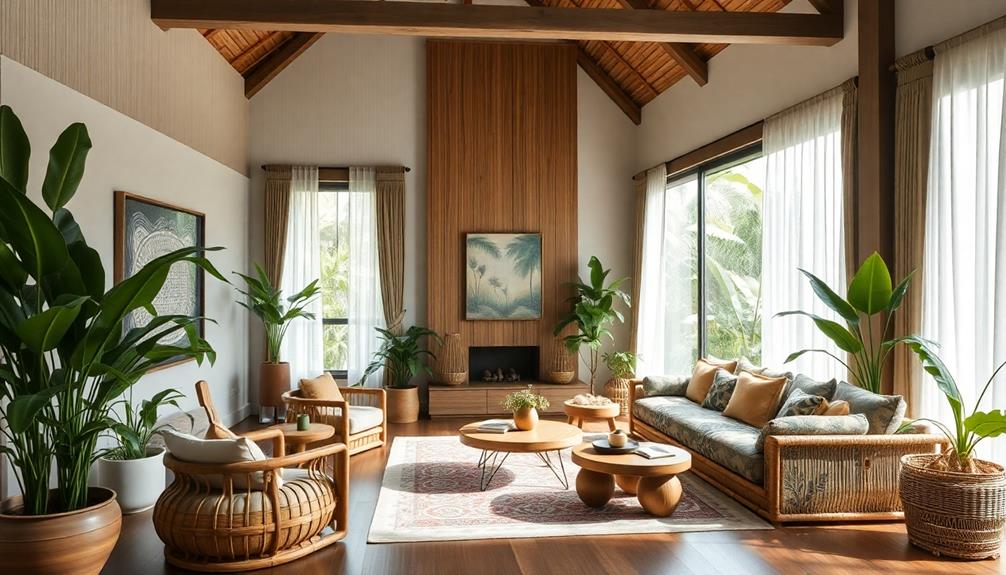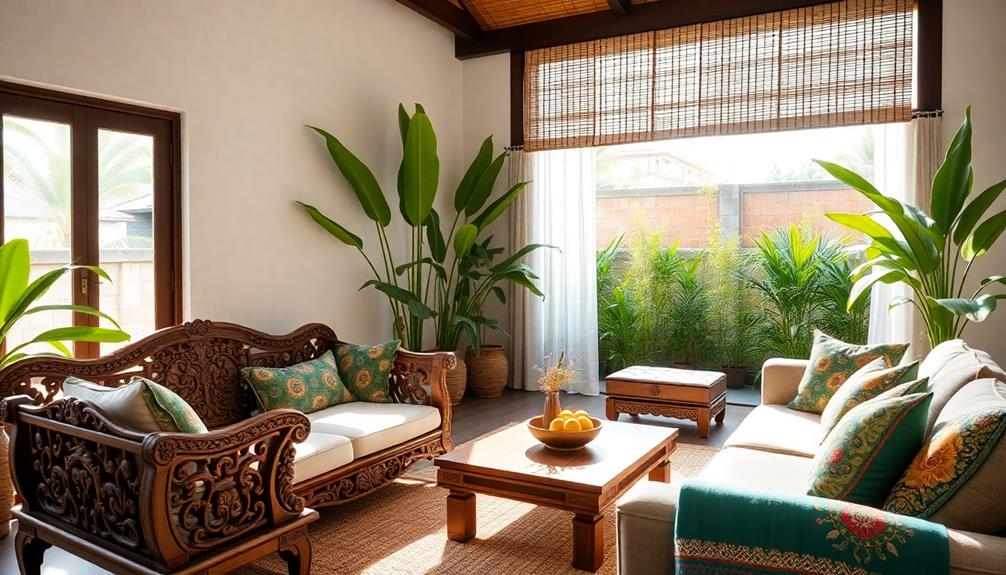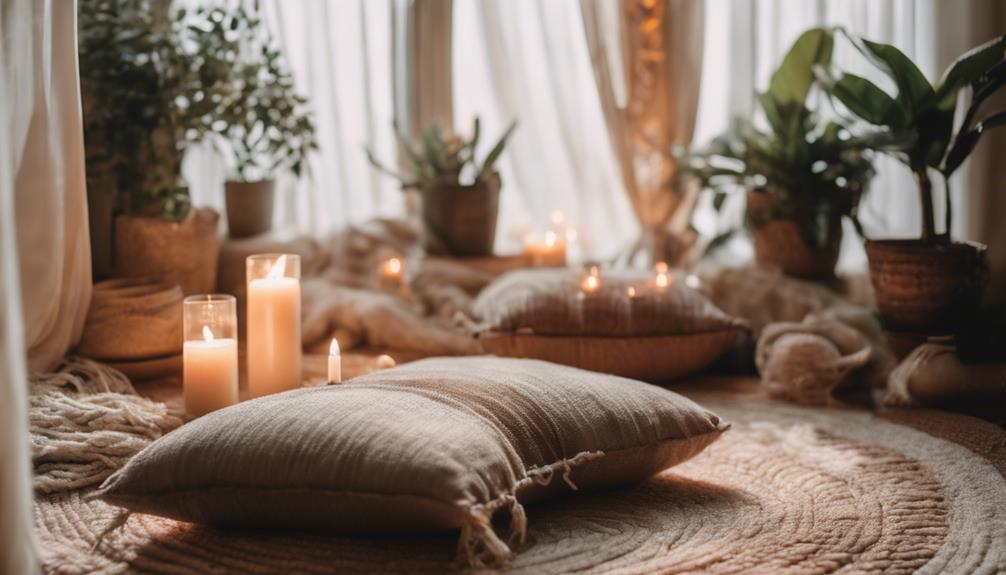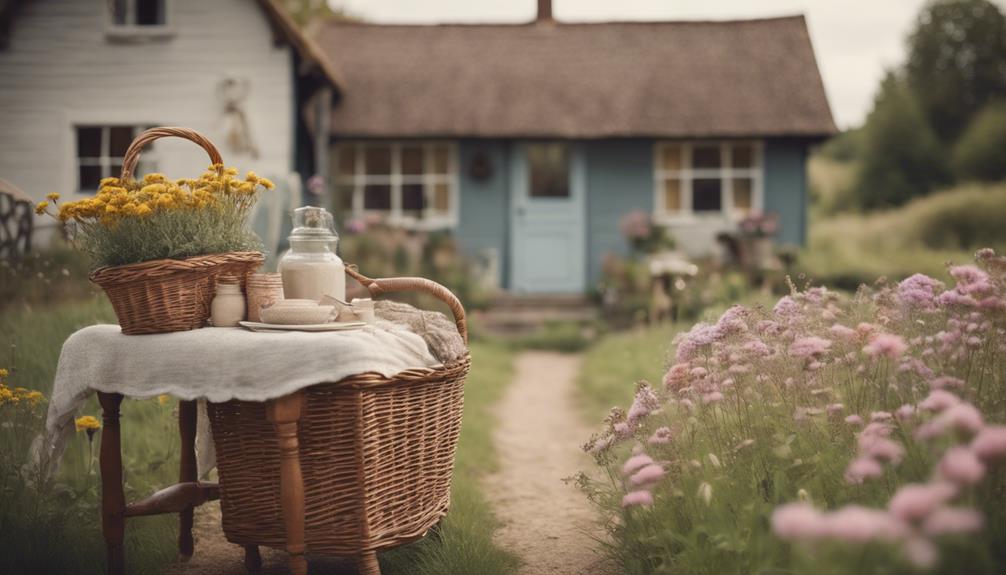To achieve sustainable Indonesian interior design, start by embracing local materials like bamboo and reclaimed timber. Maximize natural light with large windows and open layouts. Incorporating biophilic design connects your space with nature, enhancing well-being. Choose eco-friendly finishes, such as low-VOC paints and sustainable flooring, to improve air quality. Prioritize energy efficiency by using LED lighting and reflective surfaces. Modular furniture not only saves space but also supports local craftsmanship. Finally, focus on waste reduction by repurposing materials and upcycling decor. There's so much more to explore, so keep going to discover even more tips for your sustainable design journey!
Key Takeaways
- Embrace local materials like bamboo and reclaimed timber to support regional economies and reduce carbon emissions.
- Maximize natural light with large windows and open floor plans to enhance energy efficiency and indoor ambiance.
- Incorporate biophilic design by connecting indoor spaces with outdoor areas and using natural elements to promote well-being.
- Choose eco-friendly finishes, such as low-VOC paints and sustainable flooring, to improve indoor air quality and sustainability.
- Select modular furniture that allows for space efficiency and supports local craftsmanship while minimizing environmental impact.
Embrace Local Materials
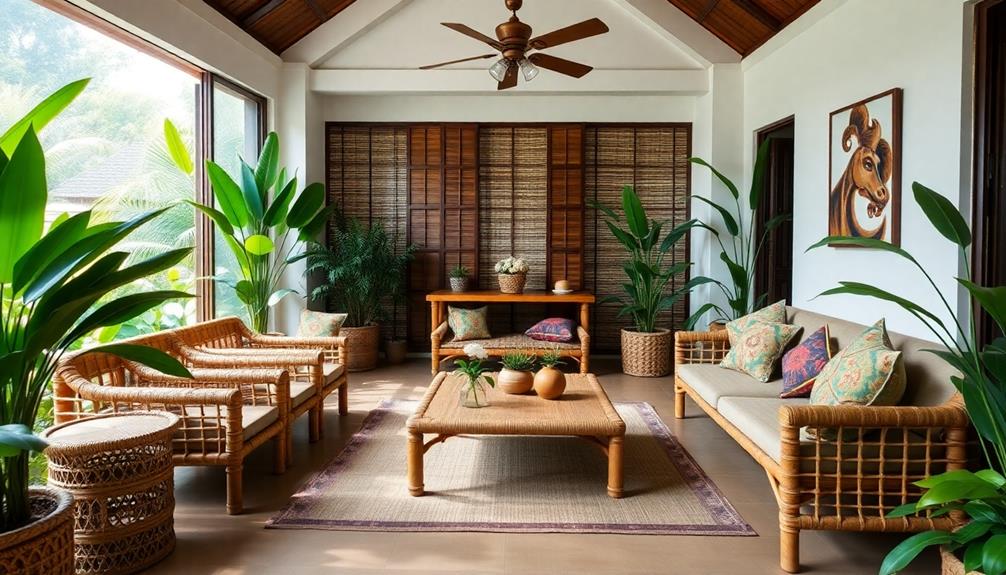
When you embrace local materials in your interior design, you're not just enhancing the aesthetic; you're also making a sustainable choice that benefits both the environment and the community.
Utilizing sustainable materials like bamboo and reclaimed timber supports regional economies while markedly reducing carbon emissions tied to transportation. This means you're creating beautiful spaces that also care for the planet.
Incorporating elements like Indonesian decorative pillows can introduce vibrant colors and intricate patterns that not only enhance your living space but also reflect the cultural heritage of the region.
Incorporating Indonesian craftsmanship, such as batik textiles and handmade ceramics, adds unique cultural value to your interiors. These local pieces reflect traditional artisanal methods, connecting you with the rich heritage of the region.
Choosing locally sourced stone or clay for flooring and wall finishes can also enhance thermal comfort and energy efficiency, perfect for Indonesia's tropical climate.
When you opt for local wood species like teak and meranti, you guarantee responsible sourcing and contribute to the preservation of native forests through sustainable harvesting.
Maximize Natural Light
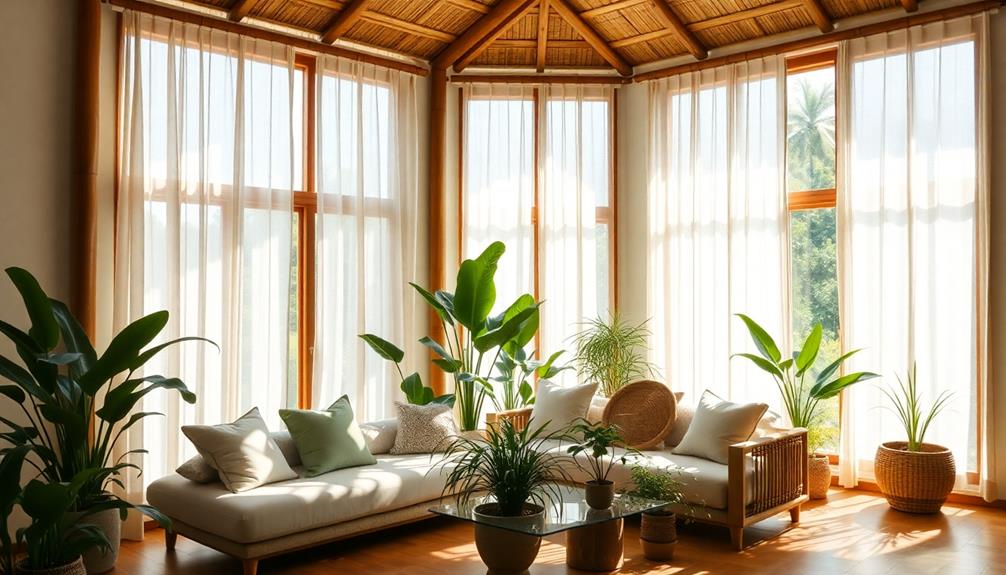
Maximize Natural Light
Incorporating local materials not only enhances your home's aesthetic but also sets the stage for maximizing natural light. By focusing on sustainable interior design, you can create a brighter, more inviting space while decreasing your reliance on artificial lighting.
Incorporating elements of Balinese design characteristics allows you to seamlessly blend nature with your interiors. Here are some effective strategies to evaluate:
- Utilize large windows and skylights to enhance natural light penetration, reducing energy consumption.
- Incorporate reflective surfaces like mirrors and light-colored walls to amplify daylight and create a more spacious ambiance.
- Opt for open floor plans that allow light to flow freely between rooms, making your home feel more expansive.
- Use lightweight and sheer window treatments to maximize daylight while maintaining privacy, letting sunlight filter through unobstructed.
- Position furniture and plants strategically to avoid blocking natural light sources, ensuring even illumination throughout your home.
Incorporate Biophilic Design
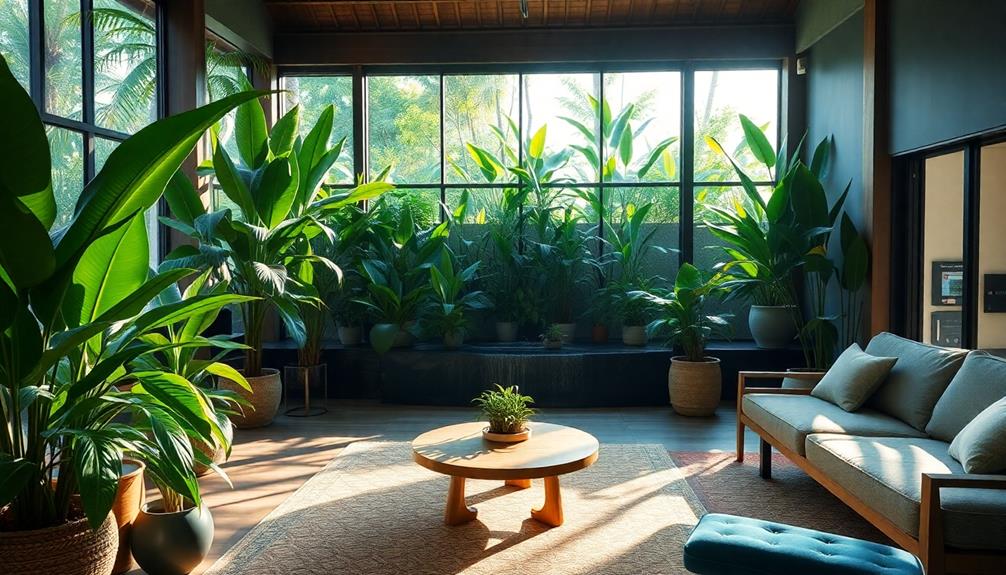
To create a truly harmonious space, you should focus on incorporating biophilic design elements that connect your interiors with nature.
By utilizing natural light, integrating indoor plants, and establishing a seamless connection to outdoor areas, you enhance both your well-being and the aesthetic appeal of your home.
Additionally, consider using local materials and furniture that reflect the essence of tropical architecture, as these choices will further promote relaxation and a sense of place.
These elements not only promote relaxation but also reflect the beauty of Indonesia's natural environment.
Natural Light Utilization
Natural light plays an essential role in creating inviting and healthy spaces in Indonesian interior design. By maximizing natural light, you not only enhance your connection with nature but also improve your overall well-being.
Incorporating elements such as traditional Indonesian style home decor can further enrich your design by embracing natural materials that complement the light. Here are some practical ways to utilize natural light effectively:
- Install large windows and skylights to allow abundant sunlight into your home.
- Use reflective surfaces like mirrors to distribute natural light, brightening dark corners and reducing reliance on artificial lighting.
- Opt for pale, neutral colors in your interiors, as they can amplify natural light, creating a warm and inviting atmosphere.
- Design open floor plans that promote daylight penetration, making spaces feel larger and more tranquil.
- Strategically place greenery to enhance the natural light experience while contributing to a calming environment.
Incorporating these elements into your design not only fosters a sustainable lifestyle but also creates a serene atmosphere that aligns with biophilic principles.
Emphasizing natural light in your home can transform your living space into a haven of comfort and efficiency, connecting you to the beauty of the outdoors.
Indoor Plant Integration
While enhancing your indoor spaces, integrating plants not only beautifies your home but also promotes a healthier environment. Indoor plants act as natural air purifiers, filtering pollutants and increasing humidity, which contributes to improved air quality.
Additionally, consider incorporating unique decorative pieces such as traditional artistry through Indonesian decor masks that reflect rich cultural heritage. By following biophilic design principles, you can create a calming atmosphere that reduces stress and enhances your overall mood.
Consider choosing native Indonesian plants like the peace lily or snake plant. These options are well-suited to local conditions and require minimal maintenance, making them sustainable choices for your interior design.
Additionally, utilizing vertical gardens or living walls can be a smart way to maximize space, especially in smaller homes. These features not only add aesthetic value but also help reduce noise pollution and improve thermal insulation.
Research shows that incorporating greenery into your home can boost productivity and creativity, making it an excellent choice for home offices or workspaces.
Outdoor Space Connection
Connecting your indoor spaces to the outdoors enriches your living environment and enhances your overall well-being. By incorporating biophilic design, you create a seamless connection that not only boosts your mood but also promotes sustainability in interior design.
Incorporating elements such as natural materials and open floor plans can further enhance this connection, reflecting the principles of modern tropical aesthetics in Bali. Here are some ways to achieve this:
- Utilize large windows and glass doors to maximize natural light and views of lush landscapes.
- Integrate indoor plants to improve air quality and enhance the aesthetic appeal of your space.
- Create terraces or balconies that allow for multifunctional living while fostering a harmonious relationship with nature.
- Incorporate water features like ponds or fountains to promote a calming atmosphere, resonating with Indonesian cultural values.
- Use natural fabrics and colors that complement the greenery, creating a cohesive and inviting environment.
These strategies not only enhance your indoor experience but also reduce stress and improve productivity.
Choose Eco-Friendly Finishes
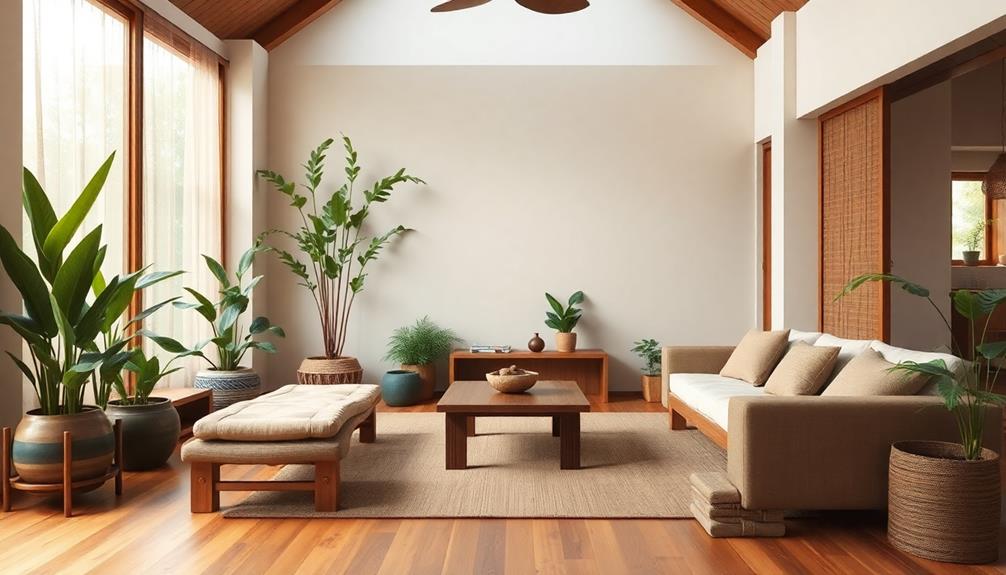
When you choose eco-friendly finishes, you're making a significant impact on your home's sustainability.
Incorporating elements from traditional Indonesian housing can inspire your design choices, as they often utilize local and sustainable materials.
Opt for low-VOC paints and sustainably sourced materials like bamboo or reclaimed wood to enhance your interior while minimizing harm to the environment.
This not only improves air quality but also adds unique character to your space.
Sustainable Material Selection
Choosing eco-friendly finishes is essential for creating sustainable Indonesian interior designs. When you prioritize sustainable materials, you'll not only enhance the beauty of your space but also support environmental and social well-being.
Incorporating elements like traditional craftsmanship, such as the vibrant and intricate designs of Indonesian decor masks, can elevate your decor while honoring cultural heritage.
Here are some key options to contemplate:
- Water-based paints: These minimize harmful emissions and improve indoor air quality.
- Reclaimed timber: This adds unique character while reducing the demand for newly harvested wood, helping preserve Indonesia's forests.
- Natural fabrics: Opt for organic cotton or linen to promote comfort and reduce chemical exposure.
- Ethically manufactured products: Choose materials that support fair trade practices, ensuring responsible sourcing and contributing to local economies.
- Upcycled materials: Incorporate these in your finishes to reduce waste and add a creative, distinctive touch to your interiors.
Low-VOC Paint Options
How can you create a healthier indoor environment while transforming your space? One effective way is to choose low-VOC paint options for your home. These paints are typically water-based, emitting fewer harmful chemicals into the air. By using low-VOC paints, you'll improve indoor air quality and reduce health risks for everyone in your home.
Furthermore, many interior design experts emphasize the importance of integrating natural elements into your space, as seen in luxury tropical designs that blend sustainability with style.
You'll find that many low-VOC paint options come in a wide array of colors and finishes, allowing you to achieve your desired aesthetic while sticking to eco-friendly principles. Additionally, these paints often feature recyclable packaging, contributing to waste reduction—a key aspect of sustainable Indonesian interior design.
Another benefit of low-VOC paints is their durability. They tend to resist fading and deterioration better than traditional paints, which means you won't have to repaint as often, saving you time and resources.
Plus, by selecting these eco-friendly options, you're supporting the local economy, as many Indonesian manufacturers are producing sustainable paints that align with your design goals. So, when you're ready to refresh your space, consider low-VOC paint options to create a beautiful and healthier environment.
Implement Energy Efficiency
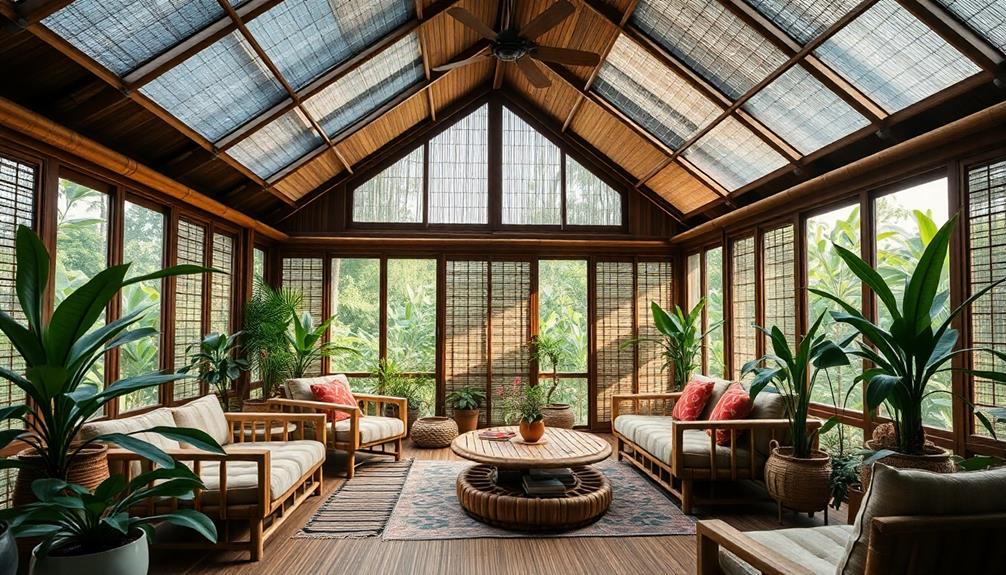
Implementing energy efficiency in Indonesian interior design not only reduces environmental impact but also enhances comfort and livability.
By prioritizing energy-efficient designs, you can notably lower energy consumption while creating inviting spaces. Additionally, incorporating traditional elements like intricate wooden carvings can add character while maintaining sustainability.
Here are some practical tips to help you achieve energy efficiency in your home:
- Maximize natural daylight with large windows and skylights to cut down on artificial lighting.
- Use pale, neutral color palettes on walls and furnishings to reflect light, brightening your space and minimizing lighting needs.
- Install energy-efficient LED lighting to lower energy costs and decrease your carbon footprint.
- Design for local climate by ensuring proper ventilation through multiple windows and open layouts, reducing reliance on air conditioning.
- Incorporate reflective surfaces like mirrors to enhance both natural and artificial light, boosting overall energy efficiency.
Prioritize Modular Furniture
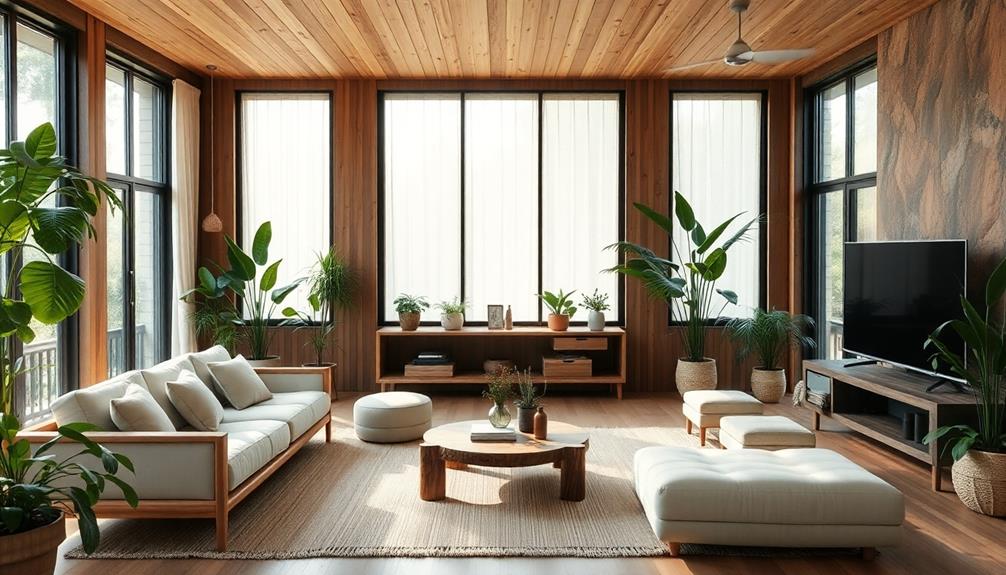
Incorporating energy-efficient designs naturally leads to the consideration of furniture that enhances both functionality and sustainability. Prioritizing modular furniture is a smart choice for your interior spaces. This type of furniture is designed to be adaptable and multifunctional, allowing you to easily reconfigure your living area as needs change. By investing in modular pieces, you can cut down on the need for multiple separate items, reducing waste and your carbon footprint.
| Benefits of Modular Furniture | Explanation |
|---|---|
| Space Efficiency | Easily rearranged to meet changing needs |
| Reduced Waste | Fewer items mean less manufacturing impact |
| Local Craftsmanship | Often made by Indonesian artisans with care |
| Minimalist Lifestyle | Encourages fewer, high-quality items |
Many Indonesian artisans create modular furniture using sustainably sourced materials, promoting local craftsmanship. Plus, modular furniture can often be disassembled and reassembled, making it easier to transport and recycle. By choosing these pieces, you're not just enhancing your space; you're also supporting eco-friendly principles and a more minimalist lifestyle.
Focus on Waste Reduction

When it comes to Indonesian interior design, focusing on waste reduction is essential for creating a sustainable environment.
By repurposing local materials like reclaimed timber from old structures, you not only decrease landfill contributions but also add unique character to your designs.
Implementing upcycling principles allows you to transform discarded items into functional decor or furniture, fostering creativity while minimizing the need for new materials.
Here are some effective strategies for waste reduction in your designs:
- Repurpose reclaimed timber for flooring or furniture to enhance aesthetic appeal.
- Upcycle discarded items into unique decor, showcasing your creativity.
- Support local artisans to utilize existing resources and preserve traditional crafts.
- Engage in projects like the Forest Recycling Project to promote material reuse.
- Adopt a circular economy mindset that prioritizes repair and reuse over disposal.
Frequently Asked Questions
How to Achieve Sustainability in Interior Design?
To achieve sustainability in interior design, you should prioritize reclaimed materials, use low-VOC paints, maximize natural light, incorporate plants, and create multifunctional spaces. This approach enhances aesthetics while promoting a healthier, eco-friendly environment.
What Is the Strategy for Sustainable Design?
Sustainable design strategies are like magic spells for the environment. You'll prioritize local materials, embrace biophilic elements, maximize energy efficiency, and incorporate reclaimed items, all while celebrating community values to create impactful, eco-friendly spaces.
How Can Interior Designers Support Sustainable Strategies Through the Leed System and Other Methods?
You can support sustainable strategies by integrating the LEED system into your designs. Focus on sustainable materials, maximize natural light, and collaborate with professionals to enhance energy efficiency and promote environmentally responsible practices in your projects.
What Is Green Design in Interior Design?
Green design in interior design focuses on creating spaces that minimize environmental impact. You'll use eco-friendly materials, energy-efficient lighting, and natural elements, enhancing both aesthetics and well-being while promoting sustainability and reducing waste in your projects.
Conclusion
So, there you have it—seven tips to create a sustainable Indonesian interior that's not just eco-friendly but also makes your friends wonder if you've suddenly become a green guru. Who knew saving the planet could come with such stylish perks? Forget the plastic plants and fluorescent lights; you're now a champion of natural beauty and energy efficiency. Just remember, when your friends ask about your chic new space, casually mention you're saving the world, one bamboo chair at a time.
